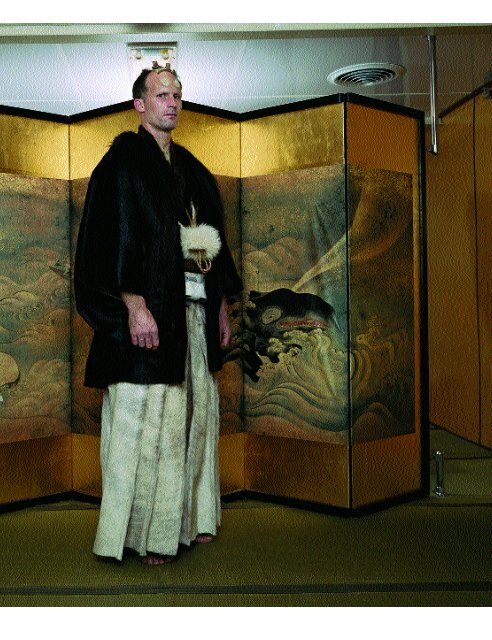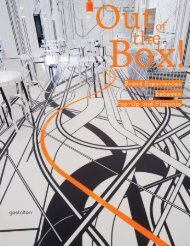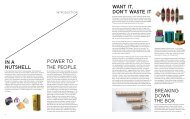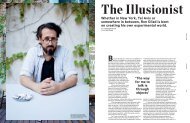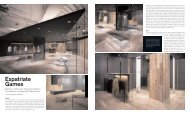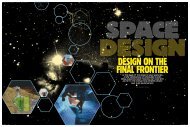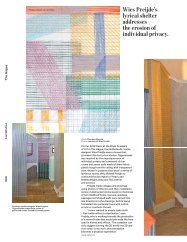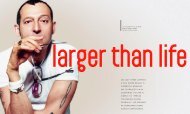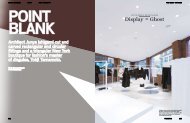POL Oxygen / Multimedia Artist / Matthew Barney - shonquismoreno
POL Oxygen / Multimedia Artist / Matthew Barney - shonquismoreno
POL Oxygen / Multimedia Artist / Matthew Barney - shonquismoreno
You also want an ePaper? Increase the reach of your titles
YUMPU automatically turns print PDFs into web optimized ePapers that Google loves.
IF ANYONE EVER INVITES YOU<br />
TO PARTICIPATE IN A FLENSING RITUAL<br />
(YOU FLENSE ME, I FLENSE YOU)<br />
IN A SMALL ROOM FLOODING WITH<br />
PETROLEUM JELLY AND WHALE SHIT,<br />
THINK CAREFULLY BEFORE YOU DECLINE.<br />
To flense means “to strip the blubber or skin<br />
from” and involves carving something up (usually<br />
a sea mammal) with a knife, plucking at tendons<br />
and exposing oozing pockets of subdermal fat. In<br />
artist <strong>Matthew</strong> <strong>Barney</strong>’s latest film – a love story –<br />
he and real-life partner, singer Björk, flense each<br />
other with expressions that suggest that they are<br />
making love with tender earnestness.<br />
Violent, grotesque, stylised, lush, <strong>Matthew</strong><br />
<strong>Barney</strong>’s films have been compared to the video<br />
game Donkey Kong (by an admirer) and <strong>Barney</strong><br />
himself to the former Republican US president<br />
Ronald Reagan (by a critic). Most of his films,<br />
which form only one part of much larger<br />
multimedia works, resemble rock operas without<br />
the music. Generally wordless, silent except for<br />
ambient sound, choreographed to the point of<br />
ritual, they are filled with opaque, self-referential<br />
symbols, and make abstractions out of the human<br />
characters and creatures out of, say, buildings. In a<br />
sentence: <strong>Barney</strong>’s films are impenetrable if you<br />
approach them as film. Nothing is ever what it<br />
seems to be: a bowl is a ship, a ship is an island, a<br />
knife is a pencil, obstacles are opportunities.<br />
Combining and recombining scores of familiar<br />
emblems – metaphors (beehives, cowboys,<br />
skinheads); historical characters and icons (Harry<br />
Houdini, executed murderer Gary Gilmore, the<br />
Chrysler Building); and celebrity actors (author<br />
Norman Mailer, sculptor Richard Serra, actress<br />
Sophia Loren) – they are simultaneously baffling<br />
and provocative. And the more you research what<br />
they are about, the more worthwhile they become.<br />
In <strong>Barney</strong>’s squat brick Brooklyn workshop, an<br />
industrial pizza oven holds racks of shallow green<br />
baking sheets heated at 250 degrees. They contain<br />
translucent beads of petroleum jelly, melting into<br />
a shallow pool that has the consistency of taffy.<br />
Half a dozen men and women are assembling the<br />
sculptures that will accompany <strong>Barney</strong>’s followup<br />
to the cult Cremaster Cycle films (1994–2002),<br />
which earned him the first Hugo Boss Prize from<br />
the Guggenheim Foundation and a solo show at<br />
the museum. Wearing his curly salt-and-pepper<br />
32 <strong>POL</strong> OXYGEN<br />
PREVIOUS PAGE <strong>Matthew</strong> <strong>Barney</strong> dressed in an elaborate costume of skin and fur that resembles<br />
traditional Japanese Shinto wedding garments, in a still from his latest film, Drawing Restraint 9. FACING<br />
PAGE A strange clown-like figure, whose costume is based on traditional Japanese Kabuki theatre, that<br />
appears at the end of Drawing Restraint 9 (this is what I can figure out but check with Shonquis to confirm.)
© MATTHEW BARNEY, 2005. PHOTO: CHRIS WINGET/COURTESY GLADSTONE GALLERY, NEW YORK
"Every one of <strong>Matthew</strong>’s films or sculptures is an<br />
exploration of the creative process, whether it’s making<br />
an artwork or making a universe…It’s about the idea of<br />
potentiality, an individual or a system realising itself."<br />
< N A N C Y S P E C T O R , G U G G E N H E I M C U R A T O R >
<strong>POL</strong> OXYGE<br />
FACING PAGE Is this the tea ceremony or something else Check with Shonquis.<br />
RIGHT In another scene from Drawing Restraint 9, the crew members on the<br />
Nisshin Maru assemble a giant sculpture made from 25 tonnes of hot petroleum<br />
jelly called The Field. As the sculpture’s mould is removed and the molten liquid<br />
cools, the ship’s passengers are engulfed in a stream of liquid jelly.<br />
hair in a ponytail at the nape of his neck, <strong>Barney</strong> is<br />
bent over a half-scale section of the whaling ship<br />
that acts as one of three main characters in the<br />
film, Drawing Restraint 9. At 39, he has an aquiline<br />
nose in a narrow face, whorls of stubble and greyblue<br />
eyes that are partitions rather than windows<br />
into the man. He is married to Icelandic singer<br />
Björk, who acted in and scored the film, and with<br />
whom he has a three-year-old daughter, Isadora.<br />
DR 9, which premiered in New York in<br />
February, forms the centre of a multimedia<br />
exhibition at the San Francisco Museum of Modern<br />
Art (SFMoMA), and is supplemented by 150 pieces<br />
of video, film, drawing, photography, sculpture (in<br />
petroleum jelly, latex and thermal plastic), and<br />
other artworks from the 12 ‘Drawing Restraint’<br />
projects <strong>Barney</strong> has completed since 1987.<br />
Unlike Cremaster, the title of DR 9 places this<br />
film explicitly in the context of <strong>Barney</strong>’s nearly 20-<br />
year-old series, which he began at Yale University.<br />
(The five Cremaster films, which took 10 years to<br />
make following his 1989 graduation, are also part<br />
of this series.) DR 9 is shorter, at two hours and 15<br />
minutes, and more watchable than the baroquely<br />
layered and wildly disjunctive six-hour, 20-minute<br />
epic that is The Cremaster Cycle. Set in Nagasaki<br />
Bay aboard the last real-life, controversial whaling<br />
ship, the Nisshin Maru, DR9 continues <strong>Barney</strong>’s<br />
exploration of the transformative and creative<br />
power of resistance to self-imposed restraint. In<br />
the film, while crew members assemble a 25-<br />
tonne petroleum jelly sculpture on the deck, two<br />
western guests (<strong>Barney</strong> and Björk) embark, bathe<br />
and are dressed in elaborate Shinto wedding<br />
costumes. They then participate in a tea ceremony<br />
and are finally deluged in a urine-colored flood of<br />
petroleum jelly as they flense each other stoically<br />
in a physically transcendent act that transforms<br />
them into whales (yes, whales) as the storm abates.<br />
DR 9 departs from <strong>Barney</strong>’s earlier work in<br />
several ways. Firstly, it has a script in the form of<br />
Björk’s highly textured soundtrack. “One of the<br />
reasons I don’t use dialogue is because I can’t write<br />
it and I can’t direct it,” says <strong>Barney</strong>. “Music takes<br />
the place of dialogue in this film. Often, as the film<br />
was written, the music was written.” Another<br />
difference: where Cremaster consists of many<br />
pieces working together to describe a single whole,<br />
DR9 describes the relationship, on a number of<br />
levels, between two things. Viewers don’t need to<br />
be acquainted with <strong>Barney</strong>’s private symbols to<br />
understand the film. “It’s lush. It’s like a fresco and<br />
it’s a love story, but it is as layered as any of his<br />
other work,” says Benjamin Weil, curator of visual<br />
arts at SFMoMA. “The idea of transformation is<br />
spelled out in a much more literal fashion, but it<br />
doesn’t lose any of its qualities.”<br />
Both more straightforward and poetic than the<br />
other films, DR 9 raises the stakes in the ‘Drawing<br />
Restraint’ series. <strong>Barney</strong>’s early pieces were a<br />
response to his unwillingness to sit and draw,<br />
which didn’t pose enough of a challenge. For<br />
DR 1, he strapped an elastic line to his thighs and<br />
anchored it to the floor. Increasing the resistance<br />
of the line by walking up an incline, he tried to<br />
draw on one of the walls. DR 6 was the only piece<br />
performed for an audience, although most of the<br />
others were videotaped. In it, <strong>Barney</strong> bounced on
a mini-trampoline while drawing his portrait on<br />
the ceiling, making one mark for each bounce. “I<br />
would do ‘Drawing Restraint’ pieces when I<br />
didn’t know what to do,” says <strong>Barney</strong>. “The idea<br />
was to set up a condition for making a drawing.”<br />
DR 7 featured his first narrative, in which<br />
wrestling satyrs “draw” on the condensation that<br />
has gathered on the sunroof of a limousine with<br />
the movement of their horns, finally flaying one<br />
another as well as the upholstery. “<strong>Matthew</strong><br />
brings the body back into the idea of making art,”<br />
says Weil. “Lots of artists have explored this, but<br />
they haven’t taken it to the degree of literality that<br />
he has. He says drawing is an easy thing to do, so<br />
he applies the whole strength of his body to put a<br />
trace on a piece of paper, to make it difficult to<br />
achieve this, bringing physicality into the notion<br />
of making art. This brings together a number of<br />
ideas that artists have been exploring in the two<br />
decades before he started working.”<br />
HAPPY MEDIUM ..................................................<br />
Born in San Francisco in 1967, <strong>Barney</strong> was raised<br />
in Idaho, where he was quarterback on his high<br />
school football team. This is where his relationship<br />
with petroleum jelly began: all the athletic<br />
equipment, from padding to balls and flags, was<br />
made from plastic. Vaseline, chaotic and formless,<br />
would become his sculptural medium of choice.<br />
Weil recalls seeing <strong>Barney</strong>’s first New York<br />
show in 1991. “The least I can say is that it was<br />
incredibly puzzling. The work was disconcerting<br />
and confusing to most people and there was an<br />
incredible amount of media coverage that was<br />
even more confusing,” he says. “Nobody I can<br />
remember who saw the exhibition was left<br />
without a strong feeling. People were either angry<br />
or excited or very, very adamantly rejecting.<br />
Nobody was looking at it like, yeah, so what”<br />
At first look, the flensing scenes in DR 9 could<br />
make a viewer adamantly rejecting. On second<br />
look, however, it’s clear that the characters are not<br />
actually in pain. “<strong>Matthew</strong> has been careful to not<br />
let it be gore,” says Weil. “It’s not sadomasochistic.<br />
They’re embracing each other and each other’s<br />
wish to transform into another state. It’s a way to<br />
spell out the symbiotic relationship that happens<br />
when a couple forms, people become one and<br />
transform themselves through a ritual. Where is<br />
the drawing in this film They’re drawing each<br />
other’s bodies with the knives.” <strong>Barney</strong> suggests<br />
that he is also visualising a metaphorical system<br />
that has valves where pressure can be released and<br />
that the seeming violence is never representational<br />
BELOW LEFT A still from Drawing Restraint 3, part of <strong>Barney</strong>’s series of attempting<br />
to draw while being physically restrained. In the third instalment, he lifted a barbell<br />
cast in petroleum wax and jelly. The chalk powder covering the barbell’s grips<br />
gradually fell onto the floor as he lifted the weight, documenting the act as<br />
drawings. BELOW RIGHT A still from Drawing Restraint 4. (Can’t find any info on<br />
this) FACING PAGE A still from Drawing Restraint 11, created specially for an<br />
exhibition at the 21st Century Museum of Contemporary Art in Kanazawa, Japan, a<br />
precursor to the SFMoMA exhibition. The piece, which was filmed in real time,<br />
documents <strong>Barney</strong>’s attempt to complete a drawing while climbing up three 12-<br />
metre-high gallery walls.
ABOVE <strong>Barney</strong>’s partner, singer Björk, dressed in the Japanese Shinto wedding costume made from animal<br />
skins in a still from Drawing Restraint 9. According to SFMoMA, <strong>Barney</strong> “became interested in Japan’s<br />
historical position as a host country to foreign guests, how the local rituals are a type of productive restraint”.<br />
38 <strong>POL</strong> OXYGEN<br />
for him. “Muscle fibre is torn in order to be built<br />
up,” he says. “I’m compelled by violence that has<br />
the potential to become sublime.”<br />
“Every one of <strong>Matthew</strong>’s films or sculptures is<br />
an exploration of the creative process, whether it’s<br />
making an artwork or making a universe,” says<br />
Guggenheim curator Nancy Spector, who worked<br />
with <strong>Barney</strong> during his solo show at the gallery in<br />
2002. “It’s about the idea of potentiality, an<br />
individual or a system realising itself.” In<br />
Cremaster 2, in one of only a few scenes involving<br />
the human voice, Norman Mailer plays<br />
Harry Houdini describing one of the magician’s<br />
famous illusions, Metamorphosis: “Within<br />
Metamorphosis, Houdini becomes part of the cage<br />
that contains him, he enters the lock and seals the<br />
bonds, he digests the lock, it becomes a part of him,<br />
the walls that imprison his body come open.”<br />
<strong>Barney</strong> has not been credited with one of the<br />
elements that is most interesting and least<br />
accessible in his work: his voluminous research<br />
into a plethora of apparently unrelated topics. For<br />
instance, the title for Cremaster comes from the<br />
word for one of the male reproductive muscles,<br />
and the cycle is filled with anatomical references.<br />
The first film represents the most ascended or<br />
undifferentiated position of the reproductive<br />
organs in the process of embryonic sexual<br />
differentiation, while Cremaster 5 represents the<br />
most descended or differentiated position. In DR 9,<br />
the ship is analogous to the artificial island, Dejima,<br />
built by 19th-century European merchants in order<br />
to be able to trade with the Japanese without<br />
stepping foot on the nation’s sacred soil.<br />
Until September 17, SFMoMA is offering an<br />
unprecedentedly comprehensive selection of<br />
<strong>Barney</strong>’s work. Don’t eat for two hours before<br />
going into the museum; it’s not easy to digest.<br />
Viewers may feel some resistance to the work it<br />
demands of us. “You don’t get a five-minute<br />
<strong>Barney</strong> experience,” Weil warns. “A <strong>Barney</strong>centric<br />
museum experience will take at least 3.5<br />
hours, but it is one of the more important<br />
functions of art to make people slow down.”<br />
Keep an eye out for the special issue of <strong>POL</strong> <strong>Oxygen</strong>,<br />
which will feature articles about other crossdisciplinary<br />
artists and performers.


